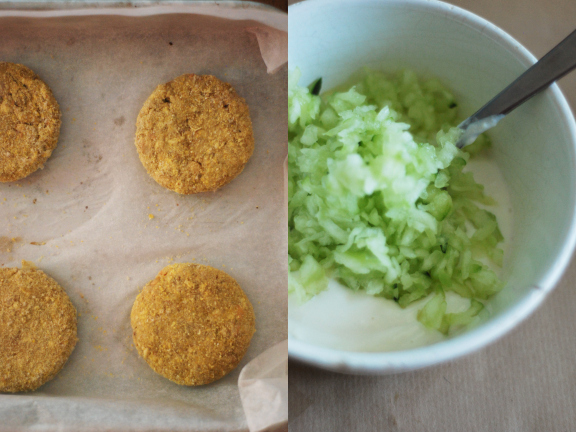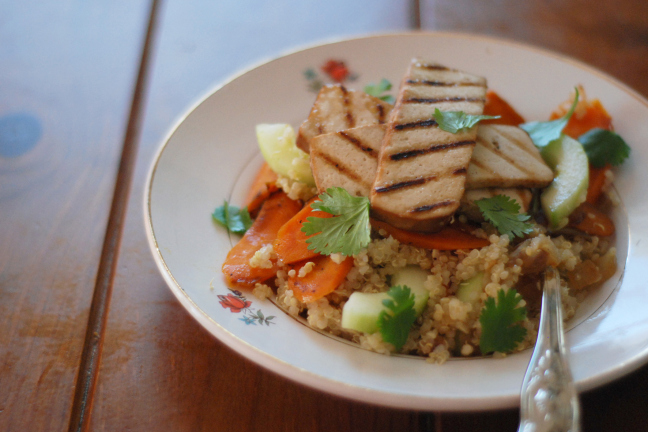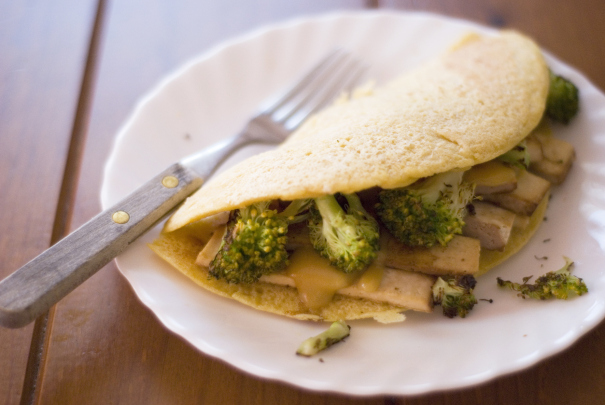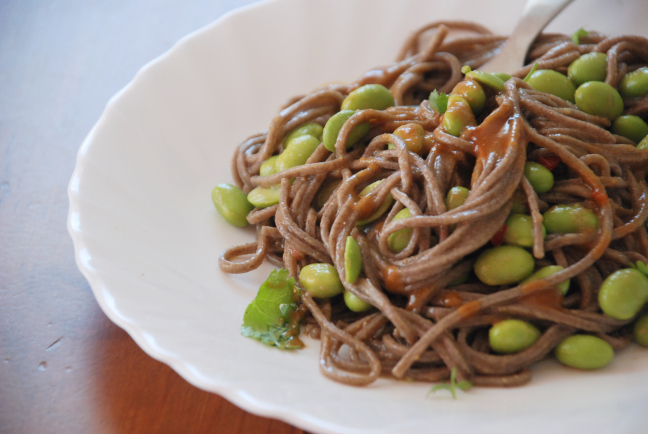Chickpea Burgers
I’ve always been afraid of making my own veggie burgers. With all my previous attempts, some kind of minor disaster had happened: most of the times, the burgers would fall apart while cooking, not keeping the perfect round shape I wanted them to keep after being cooked. So today, I was determined to make the perfect veggie burgers I was dreaming on for such a long time. I had some cooked chickpeas sitting on the fridge, so I haven’t thought twice: I’d be making chickpea burgers.
I came to a conclusion: my previous attempts failed because there wasn’t any ingredient binding all the other components of the burger, hence their loss of structure. How I wish I had realised that sooner… This time around, not only the burgers kept their shape, thanks to the addition of ground flax seeds and tahini, as they were delicious in their own right. I served them with wholegrain bread, tzatziki, peach salsa, and grilled gram flatbread, that I sliced into the shape of fries and grilled right after the burgers were done. But feel free to serve them with whatever condiments and fixings you like. Next time around, I might serve these burgers with a barbecue sauce or top them with an apple and zucchini chutney.
Chickpea burgers
(makes 6 burgers)
2 cups cooked chickpeas (canned is fine)
½ cup breadcrumbs
1 teaspoon salt
1 tablespoon ground cumin
1 tablespoon coriander seeds
2 small garlic cloves, minced
2 teaspoons curry powder
1/2 teaspoon black pepper
1 tablespoon tahini
2 teaspoons flax seeds
5 tablespoons water
95 grams extra firm tofu, crumbled
½ cup cornmeal
zest of ½ lemon
1. In a large bowl, combine the chickpeas, breadcrumbs, ground cumin, coriander seeds, curry powder, pepper, minced garlic, salt and crumbled tofu. Set aside.
2. In a coffe grinder or food processor, grind the flax seeds. Add the tahini and slowly pour the water, processing everything until you get a mixture with the consistency of a thick sauce. This will work as a binder.
3. Add the flax seeds and tahini mixture to the large bowl. Mix well all the ingredients.
4. Put all the ingredients in a food processor. Process until everything comes together. Don’t bother if the mixture isn’t totally smooth; it’s actually great to find some small bits of chickpeas in there, as they add some crunchiness to the burgers.
5. Divide the mixture into 6 equal portions. With your hands, form round patties that are about 8 centimeters in diameter and 1 centimeter thick.
6. In a deep plate, combine the cornmeal with the lemon zest. Dip the patties in the mixture, shaking off the excess cornmeal.
7. Put a large grilling pan, previously brushed with olive oil, over medium-high heat. When it’s hot, but not smoking, add the patties.
8. Cook the patties for about 8 minutes on each side, turning them only once.
9. Serve them right after cooking.
Note: The burgers are quite firm and really hold their shape while grilling. Due to the low content of fat in the recipe, it’s really necessary to brush the grilling pan with olive oil to prevent them from sticking. For this very same reason, I don’t think that baking them would be a great idea, as baking usually absorbs a lot of moisture and would make the burgers a bit too dry, even if you brush the baking sheet with oil. On the other hand, and as an alternative to grilling, you could heat a large skillet with 1 or 2 tablespoons of oil and cook them over medium-heat for the same amount of time (8 to 10 minutes on each side) until golden brown on both sides.
Quinoa Salad
If you’re already disappointed to see another salad showing up here, I can only arguee that, being a big salad eater, I can’t help myself but posting salad recipes, as they are a very important component of my everyday eating. I know this might sound like common sense, in the way that most of the people I know think that vegans and vegetarians live on salads. But, as we all know, the word salad isn’t necessarily a synonym for lettuce leaves and raw tomatoes tossed with a boring dressing mostly made out of olive oil and vinegar (at this point I think I’m more describing the classic portuguese salads served on restaurants and cafés rather than anything else, although the criticizable protuguese way of making and serving salads would make an interily new post, and I’ll leave it for another occasion).
Salads, at least for me, when balanced in nutrional terms, make wonderful main courses. This quinoa salad is one of those all-in-all meals: you have the grain (quinoa), veggies (carrots cucumbers and caramelized onions) and a source of protein (grilled tofu), all tossed with a (I promise) not-so-boring brown rice vinegar and ginger dressing. It’s the kind of food I usually have for lunch (and dinner, if I happen to have some leftovers). Well, it’s actually my kind of food. If you give it a try, I hope you like it as much as I do.
Ingredients:
(serves 3)
¾ cup quinoa
2 x ¾ cup water (approximately 300 ml)
3 medium-size carrots, peeled and cutted into thin rounds
1 large onion, chopped
1 small cucumber, peeled, seeded and diced into 1cm thick rounds
250 gr tofu, cutted into slabs
2 teaspoons tamari
2 tablespoons chopped coriander
for the dressing:
4 teaspoons agave nectar
2 teaspoons olive oil
4 tablespoons brown rice vinegar
1 tablespoon freshly squeezed ginger juice
1. Start by cooking the quinoa: bring a pot with the water to a boil and add the grains. Reduce the heat to low-medium, and let simmer, covered, for 20 minutes, or until all the water is evaporated. Add a pinch of sea salt (about ¼ teaspoon) and a drizzle of olive oil when it’s done.
2. Heat one tablespoon of olive oil in a frying pan, add the onion, a pinch of salt, and let it cook, stirring occasionally to prevent it from sticking to the pan, for at least 10 minutes, or until deeply caramelized. Transfer to a bowl and set aside.
3. In the same pan in which you cooked the onion, add the carrots. At this point, you don’t need to add more oil. Cook the carrots for about 3 to 4 minutes on each side, or until they get crispy and toasted. You might want to do this in several batches, in order not to overcrowd the pan and to have the slices evenly cooked. When they’re done, transfer them to another bowl and set aside.
4. Brush the tofu slabs with olive oil. Place them in a hot grilling pan, and grill for about 4 minutes on each side. Transfer to a plate and toss with the tamari.
5. In a small bowl, combine all the ingredients for the dressing and whisk well.
6. Transfer the quinoa, onion, carrots and diced cucumber to a large bowl and toss with the dressing.
7. To serve, divide the salad into 3 deep plates and pile the tofu atop salad on each plate. Sprinkle with chopped coriander.
Gram Omelette
I had never heard about gram omelettes until last saturday. I was having dinner at some friends house when one of them spelled the magic words: “vegan gram omelettes”. I’ve never been a fan of omelettes. But omelettes do really bring me back good moments. And by good moments I mean all those very late dinners with my boyfriend when, having nothing but some eggs and cheese sitting on the fridge, I’d cook a cheesy omelette for the two of us. We’d then enjoy it along with a simple leafy salad, some grains (usually couscous or bulgur), and a glass of wine. It was simple, tasty, and filled our bellies.
But since I’ve been cooking more and more vegan food, I almost forgot about omelettes. I though I could never reproduce it, or at least make something similar to it in texture, as I don’t care too much for the taste of the real thing. Gram flour not only does the trick as it also packs a lot of flavor. The texture of this version is more dense than the one of the omelette made with eggs, but at the same time I found it more satisfying and it really brightens the unique flavor of this particular flour. I like to fold my omelette and fill it with some grilled tofu, pan fried or raw vegetables, and a simple sauce. In the picture above, I drizzled some of leftover tofu marinade I had on hand (made of white miso and mustard), but a yogurt sauce with some chopped herbs would also be a great option. Actually, the possibilities for the filling are endless, just use your own creativity and intuiton and go for it. My boyfriend hasn’t tried this yet (I’m looking forward to it), but I bet this will soon replace the egg omelette as our late night dinners fave. Miss you.*
Ingredients:
(makes one omelette of, approximately, 23 cm)
50 grams gram (chickpea) flour
1/2 cup plus 3 to 4 tablespoons of water
olive oil
salt
pepper
1. In a medium bowl, mix the flour with the water and add salt and pepper to taste. If the batter is too thick, add a bit more of water. The consistency you want to achieve is that of a beaten egg.
2. Lightly brush a medium size non-stick skillet with olive oil, and heat it to medium-hot. When it’s hot (about 2 or 3 minutes minutes after you have turned on the heat), pour the batter on the pan and cook for about 3 to 4 minutes, or until is golden brown on the bottom, and the top is almost set. Carefully flip with a spatula and cook the other side for another 3 to 4 minutes. Transfer to a plate, cut in half, and fill it with tofu and/or vegetables, or whatever you prefer.
Soba Noodles with Edamames and Miso Dressing
This post will lack an introduction, but as I’m not very good at it (and I already introduced myself and the purposes of this blog in the about section), I’ll go straight to the issue: vegan recipes. And to start with, I’ve choosen one that is actually a favorite in this household. It’s a recipe for soba noodles with a tangy miso dressing that I fell in love with the first time I tried it. The dressing is a perfect match to barely cooked edamame beans, which give some crunchiness and add proteins to the dish. If you don’t have edamames at hand, I bet some chickpeas, cooked and lightly toasted on the pan, would also make it. Quick, nutritious and healthy, perfect for this time of the year, when you don’t feel like spending that much time in the kitchen and just want to throw lunch in a couple of minutes. Soba noodles with edamames and miso dressing, here we go.
Ingredients:
(serves 4)
225 gr soba noodles
1 and 3/4 cups edamame beans
For the dressing:
3 tablespoons miso (choose a light variety, such as Mugi)
4 tablespoons lemon juice
6 tablespoons orange juice
2 tablespoons olive oil
1 tablespoon toasted sesame oil
2 and 1/2 tablespoons agave nectar
1 fresh red chili pepper
1. In a bowl, combine the ingredients for the dressing. Whisk until well incorporated, cover and set aside.
2. Pour about 2 liters of water in a pan, let it boil, and add the edamame beans. Cook the beans for 2/3 minutes. Drain and wash them under cold water.
3. Return the pan to the stove, let the water boil again (use the water in which the beans were cooked) and add the noodles. Cook for 6 to 7 minutes. Drain and wash under cold water.
4. In a large bowl, combine the beans and soba noodles. Stir in about 6 tablespoons of the dressing and mix well.
5. Serve at room temperature and drizzle some more dressing on top of each plate if you like.






2 comments